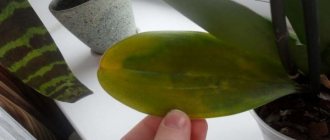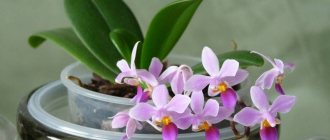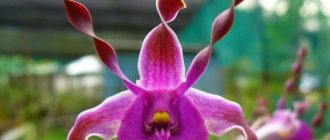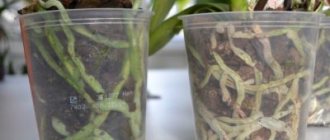It is not for nothing that orchids are not only exotic and rare plants. But they are also considered capricious tropical beauties .
Of the numerous species, lovers have a limited number of them. Not like the famous Orchid Park in Singapore.
Orchids are no longer something outlandish.
Just like it was just recently. But they still admire them. And not by chance. Their well-known centuries-old history confirms this:
- In Ancient China : Artists depicted Coelogina and Cymbidium;
- “The words of dear friends are the most delicate scent of orchids.” This is how the famous Chinese thinker Confucius wrote about orchids;
In ancient times, only rich and noble people could purchase orchids. - In writing, hieroglyphs were used according to their description : Orchid - Lan;
- Heavenly Orchid – Tin Lan;
- Orchid scent - Lan Fong.
But they are also susceptible to various diseases . Let's find out in more detail below how to save an orchid without roots and without leaves.
Causes of loss of roots and leaves
conditions for natural growth in a house or apartment . Even numerous hybrids specially bred for growing at home.
So we have to deal with various diseases. I don’t really want to lose quite valuable and expensive specimens.
The desire of flower growers to try to save even hopeless plants is understandable. It is important to accurately determine the causes of problems with roots or leaves.
And this can happen due to mistakes and miscalculations in caring for plants. Their inconsistencies with the type of orchid :
- Incorrect watering . Both extremes are harmful. Both drought and excessive watering;
- The quality of the substrate does not allow the roots to perform their functions. After all, even an ideal one becomes unusable after 3-4 years. And even earlier. Because of this, either drought or stagnation of moisture is formed;
- A cramped pot for an orchid. She has grown and needs a larger container. So he suffers in cramped conditions;
- Excessive temperature and humidity lead to diseases. As well as understated ones;
- Poor quality lighting does not provide the required amount of light. Such plants also fall under the scorching rays of the sun;
- Pests and diseases (especially fungal ones) can weaken plants. Without proper response, the plants will die;
- A strong passion for fertilizing , especially an overdose, will not do anything good for plants. Only harm;
- Damage to roots and leaves during transplantation;
- This most often occurs in the autumn-winter period.
An orchid may lose leaves due to improper care.
There is a close relationship between the condition of roots and leaves . As soon as problems form with the roots, they will immediately affect the leaves. The roots provide the leaves with the necessary amount of moisture. Healthy roots cope with this successfully.
Their inspection by experienced flower growers allows them to detect dried and rotten ones . The condition of the plants and your conditions determine the methods used to save orchids. You need to know them in order to skillfully apply them.
Preventive measures
Lack of care or excessive zeal in care have a negative impact on the health of tropical beauties. And so that the orchid does not get sick, and this primarily depends on the health of the root system, you need to follow basic rules of care and create acceptable conditions for growing :
- Epiphytes in their natural environment receive nutrition from the air and incoming moisture.
This is enough for them to fully develop. The substrate mainly plays the role of stability of the plant in the container and its support. Therefore, the issue of adding additional nutrition at home is very acute. Fertilizer application must be done with extreme caution and preferably with special complexes. Overfeeding and high concentrations of fertilizers are likely to cause root death; - Watering is required only with clean, settled or distilled water . The best option is melt or rain water, which is the main supplier of moisture in natural conditions;
- Orchids cannot be flooded . The roots must dry out before the next watering. This is based on the physiological characteristics of velamen. It accumulates moisture and only then gradually releases it;
- It is advisable to water in a tray or by immersion . Sometimes it is recommended to spray “fog” on the leaf surface and roots;
- Change the soil in a timely manner, preventing it from becoming salty and compacted. Before using a new substrate, it should be treated against pests and infections;
- It is best to choose a container for plants that is transparent , with a sufficient number of drainage holes to drain excess water and circulate air. Its size should correspond to the size of the root part;
- should be placed , avoiding direct sunlight;
- Protect the root part and the plant itself from cold, drafts and overheating.
Important! It is required to have knowledge of various methods of resuscitating orchids.
Application of root formers
Which ones are on sale?
What kind of drugs will not be offered to you for the rehabilitation of orchids. Especially the market. Be careful.
Specialists and flower growers do this more discreetly . They advise creating the conditions necessary for plants. And purchase such drugs in specialized stores.
How to apply it correctly?
Radifarm. Various herbal extracts:
- To stimulate root growth;
- Successful rooting of plants. And orchids;
- Improves survival rate during planting and transplantation.
One drop of product is enough for one liter .
Kornevin. Hormonal biological product. Root formation stimulator:
- Dry powder : Mix with activated carbon in equal parts. With fungicide – 1 to 10;
- Dust the cuts. And shake any excess from the plants.
Kornevin can be used both in dry and soluble states.
Embiko. Liquid preparation. Has a whole range of microelements:
- 2 caps per liter of water is enough;
- Use boiled water;
- Orchids without roots are placed in this solution.
Master Tsvet or Gilea (Master Tsvet).
Ukrainian complex fertilizer:
- Dilute 2 caps of the product in boiled water;
- And place the plant in this solution.
Ribav-Extra. The drug is used to treat plants:
- Add 1-2 drops per 1 liter of water;
- Can be watered after 7-10 days. Or spray;
- Particularly effective during transplants and other stressful situations;
- Shows positive results in the formation of roots in phalaenopsis.
Flower growers also speak well of other drugs and fertilizers for resuscitating orchids:
- Zircon;
- Etamon (a fairly new drug).
Reanimation
If rotting of the root mass of an orchid is noticed, then it must be revived as quickly as possible, and this important task begins with replanting the plant.
Assessment of the aboveground part of the plant
First of all, you need to inspect all leaf plates for the presence of pests . If they are noticed, then you need to treat the plant with the appropriate preparation the required number of times to get rid of them.
Before starting resuscitation, you should get rid of pests.
If the root mass is damaged we do not remove yellowing and yellow leaves until the plant has completely used them to build new roots. The plant, eating its own foliage, grows roots, and removing leaves is the main mistake of novice orchid growers.
IMPORTANT! Actually, the more leaves, the more chances the orchid has to grow roots and survive.
Thorough pruning of all roots and rotting areas
The second step is to inspect the root system and assess the damage caused by rotting . Therefore, we shake off the bark, and if it has grown somewhere to the velamen, then there is no need to tear it off, since the root structure can be damaged. If the purchased orchid grew in denser or moisture-absorbing soil, then the roots should be washed with warm and soft water.
After removing the substrate, inspect the roots and remove everything :
- Rotten;
- It's dry;
- Releases liquid;
- Broken.
It is best to remove damage with pruning shears , since after it the wounds heal quickly. After removal, all sections made are treated with one of the following drugs:
- Charcoal;
- Activated carbon;
- Cinnamon;
- Zelenka.
After removal, it is necessary to treat with an appropriate fungicide and leave the flower to dry on a newspaper for 6-8 hours.
Placement in water to growth point
This is the most basic way to grow a young root system in a plant and how to save it from death. Soft water is poured into a transparent glass container and disinfected with an activated carbon tablet dissolved in 250 g. water. The reanimated flower is lowered into this water so that the growing point is in the air.
Resuscitation of an orchid in water.
In this case, the container should be in a bright place with an ambient temperature of at least 23 degrees Celsius. Therefore, in winter, such plants are placed near heating devices and additionally illuminated with lamps for plants. After some time, the beginnings of roots will appear.
IMPORTANT! Such an orchid is planted in the substrate only when the roots exceed a length of 5 cm.
The Importance of Light Mode
The light regime is very important not only for a plant that is in the process of resuscitation, but throughout its entire life. Without scattered sunlight, the process of photosynthesis does not occur . Actually, if there is not enough daylight, the leaf mass becomes faded, and the roots may begin to die.
results
The first roots will appear in about a month , but this is provided that the grower has not deviated from the recommended rules.
There are slow-witted plants, you seem to do everything as it should, but it stands there like plastic: it neither grows nor dies. But that rarely happens.
For the most part, orchids are quite tenacious plants with a great desire to live and bloom.
Using foliar feeding on leaves
If the plant refuses to grow a new root system, you can fertilize the leaves . It is carried out:
- Using a solution of succinic acid. In this case, the solution for processing the leaf mass is made at the rate of 1 t per 250 g. water;
- There are special vitamin cocktails , for example Dr. Foley, with the help of which foliar feeding is carried out.
IMPORTANT! Do not expose orchids treated by leaf to sunlight, as they may get burns to the leaf mass.
What to do with aerial roots?
They must be directed to grow towards the bark and covered with sphagnum moss so that the moss itself lies on the roots, but does not touch the trunk of the plant . From time to time this moss is sprinkled with water to increase humidity. But it would be best to transplant such an orchid into a higher pot to hide the aerial roots with a substrate.
Features of foliar feeding
Alternate foliar feeding root feeding:
- Hold them in the evening;
- Experts recommend using Doctor Foley Orchid;
- Before spraying the leaf, slightly moisten the substrate;
Succinic acid is often used for foliar feeding. - Regular succinic acid is often and effectively used for roots. Flower growers recommend wiping the leaves (top and outside) with a cotton swab. Pre-moisten it in succinic acid dissolved in water.
One tablet per glass of water . To increase immunity in plants.
How to distinguish healthy roots from rotten ones?
You can determine that the roots of an orchid have begun to rot by external signs or by experiment.
The first way is to determine by appearance and touch:
- the color of the roots is dark, almost black;
- there is mucus and fluid;
- presence of mold;
- a putrid odor emanates from the roots;
- the roots became thinner and became thread-like.
Root rotting is determined empirically as follows. The plant is removed from the pot and its roots are immersed in water for 3 hours. If the roots are healthy, they will quickly become saturated with moisture and become elastic. If the roots continue to remain pale and limp, then they are infected.
Do I need to remove the peduncle?
The orchid peduncle develops successfully and forms the buds of a healthy plant due to the roots and leaves :
- But if everything is not in order with them, then they cannot ensure full development of the peduncle;
- Experts advise cutting off the peduncle, depending on the condition of the orchid itself. But only the apical part;
- A reanimated orchid needs strength to restore its roots and leaves. Then the flowers will grow;
- But the plant may die. If he cannot cope with the provision of a peduncle. You decide.
Is it possible to grow an orchid from a leaf?
- The leaves do not have a growing point . And it is impossible to grow them from a leaf. That's what the experts say;
- Can. Confirmed by amateur flower growers. They do it and show it.
An orchid can be grown from a single leaf.
The result of patience and perseverance :
- Water in container;
Growing a single leaf orchid requires patience. - The leaves were placed in water;
- The bases of the leaves are not immersed in water.
Root growth in children
In most cases, orchid babies also form roots . There are cases when such roots are missing.
Few options:
- You can continue care and wait for the roots to appear;
- Or you can stimulate their appearance : Equip a nest of damp moss at the base of the baby. And make a neat wrap of cling film;
- Reinforce it with thread;
- If it is on a peduncle, install an additional stick;
- Ventilate daily;
- Spray with Kornevin.
Aftercare rules
The resuscitation process, as well as the problem that led to it, is a significant stress for the orchid. After completing the transplant procedure, the plant should be given time to recover. To do this, just follow a few recommendations:
- place the reanimated orchid in a warm, sufficiently lit place, protecting it from drafts and direct rays;
- do not water the plant for 10-14 days; in case of emergency, a small spray is enough;
- after resuscitation, do not use fertilizing or other chemical treatments for about one and a half months;
- Be sure to adjust care regimens and follow them strictly.











